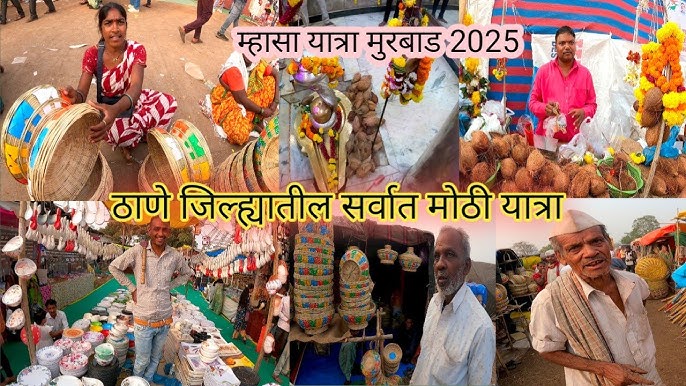In the heart of Murbad Taluka, nestled in the lap of the Sahyadri hills of Maharashtra, lies a village called Mhasa. For most of the year, it stays quiet and serene. But come Pausha Purnima—the full moon day in the Hindu month of Pausha—Mhasa transforms into a vibrant celebration of faith, community, and tradition during the much-awaited Mhasa Jatra (Yatra).
I had always heard stories about this legendary fair—of its massive cattle market, glowing lights, temple festivities, and the crowds that came not just to trade, but to celebrate life. This year, I finally decided to experience it for myself.
A Sacred Beginning
Our day began early. As the sun slowly rose over the hills, we arrived at Kamblingeshwar Temple, the spiritual center of the yatra. Devoted to Lord Mhasoba—a form of Lord Shiva and the village deity—the temple was already buzzing with chants, ringing bells, and pilgrims offering flowers, coconuts, and prayers.
Families stood in long yet peaceful queues, waiting patiently for darshan. The air smelled of incense, turmeric, and fresh marigold. Locals believe that offering prayers here brings protection to their farms, families, and especially their cattle.
Inside the sanctum, the atmosphere was serene and powerful. I saw people of all ages bowing their heads, seeking blessings before stepping out into the fairgrounds. There was a warmth in their faith, passed down through generations.
The Grand Bazaar of Life
Walking out of the temple, the fair opened up like a festival of colors and sound. On one side, a sprawling animal bazaar stretched across fields, with well-fed bulls, cows, and goats lined up proudly by their owners. Many were adorned with colorful cloth, bells, and even flower garlands.
Farmers and traders, some from neighboring districts, examined the animals with care. Deals were made with handshakes and smiles. For many, this was more than trade—it was tradition. It was a celebration of the bond between people and their animals, built on trust and respect.
In another section, stalls overflowed with Solapuri blankets, woolen shawls, woven baskets, and clay pots. Local women sold handmade sweets like khaja, pedhe, and gulab jamun, while men roasted peanuts and made hot bhajis that filled the air with a tempting aroma.
Carnival Moments
As the day warmed, the mood shifted into celebration. Children ran to colorful fair rides—Ferris wheels, swings, toy trains—shouting in delight. Laughter echoed from game stalls where people tried their luck at throwing rings or popping balloons.
Everywhere I looked, there was joy—families shopping, friends taking selfies, and vendors calling out with friendly banter. One lane was filled with stalls selling glowing balloons, wooden toys, bangles, and winter caps.
In a quieter corner, elders sipped chai and chatted beneath the shade of a tree, discussing harvests and village news. It reminded me how such gatherings not only sustain traditions, but also reconnect communities.
Faces of the Yatra
One of the highlights of the yatra was meeting the people behind the scenes. Volunteers guided the crowd with patience, ensuring safety and cleanliness. “We’ve been attending this yatra since childhood,” said one young man with a smile. “Now we help others enjoy it too.”
There were families who had traveled for hours just to offer prayers and meet loved ones. A group of women in traditional nauvari sarees welcomed me to their stall with homemade laddoos. “This is our once-a-year moment,” one of them said, “where work, worship, and celebration all come together.”
A Celebration That Lives On
As evening approached, the lights came on, giving the fair a magical glow. The temple stood bathed in golden light, while music played softly through speakers nearby. Devotees continued to arrive, some lighting camphor, others simply sitting in quiet reflection.
I walked back slowly, taking in the sights—children asleep in their mothers’ arms, elders carrying baskets of offerings, and countless small moments that stitched together a beautiful tapestry of devotion and culture.
Why Mhasa Yatra Matters
What makes Mhasa Yatra truly special is its spirit. It’s not just a fair—it’s a living tradition. It brings together faith and festivity, devotion and commerce, the old and the new. It celebrates not just a deity, but the values of community, simplicity, and gratitude.
From the temple bells at dawn to the last glowing balloon at night, every moment is filled with life.
If you ever find yourself in Maharashtra during January, don’t miss the chance to witness this unique celebration. Mhasa may be a small village, but for a few days each year, it becomes the heart of a tradition that beats with the pulse of rural India.


Comments are closed